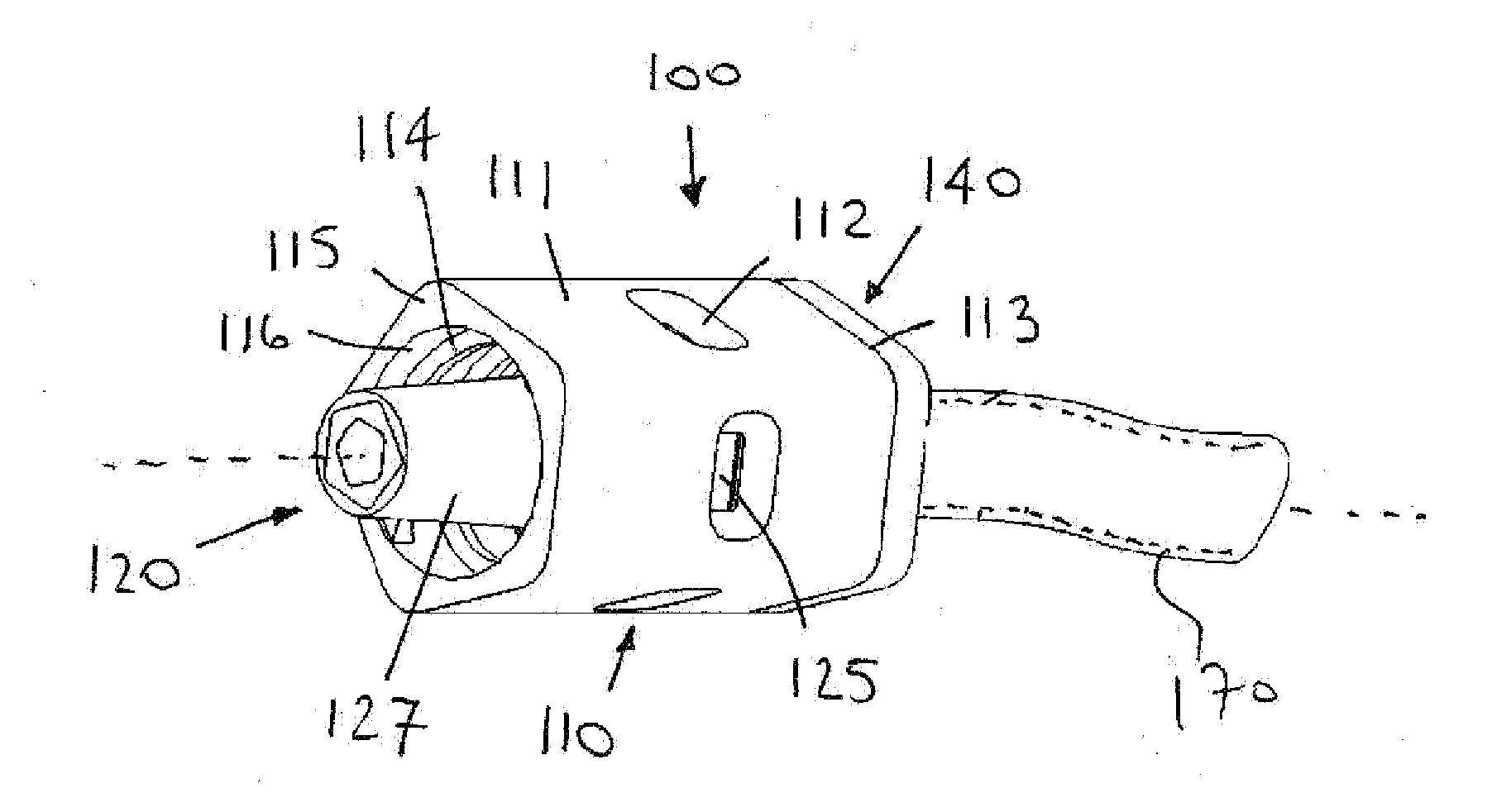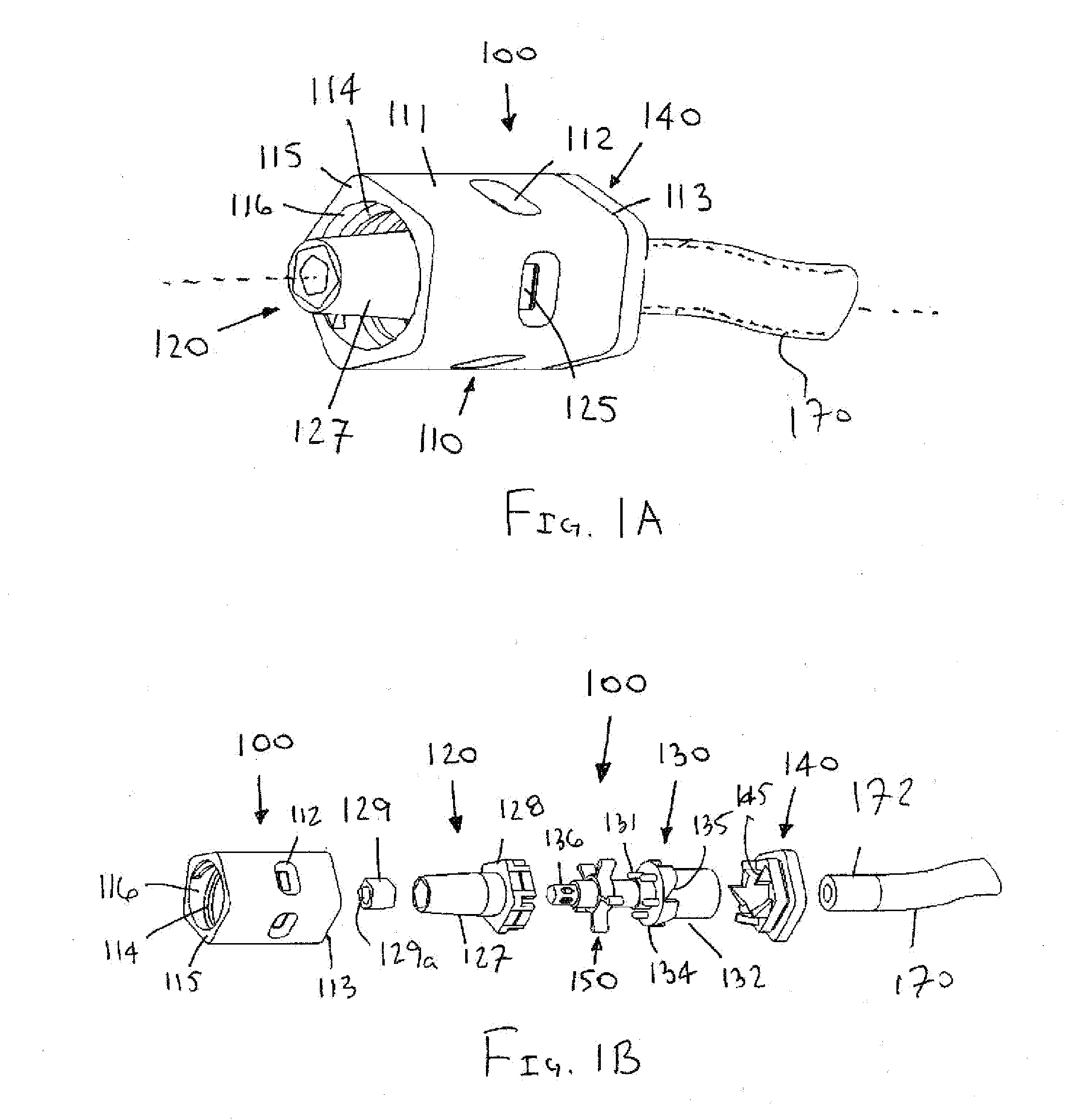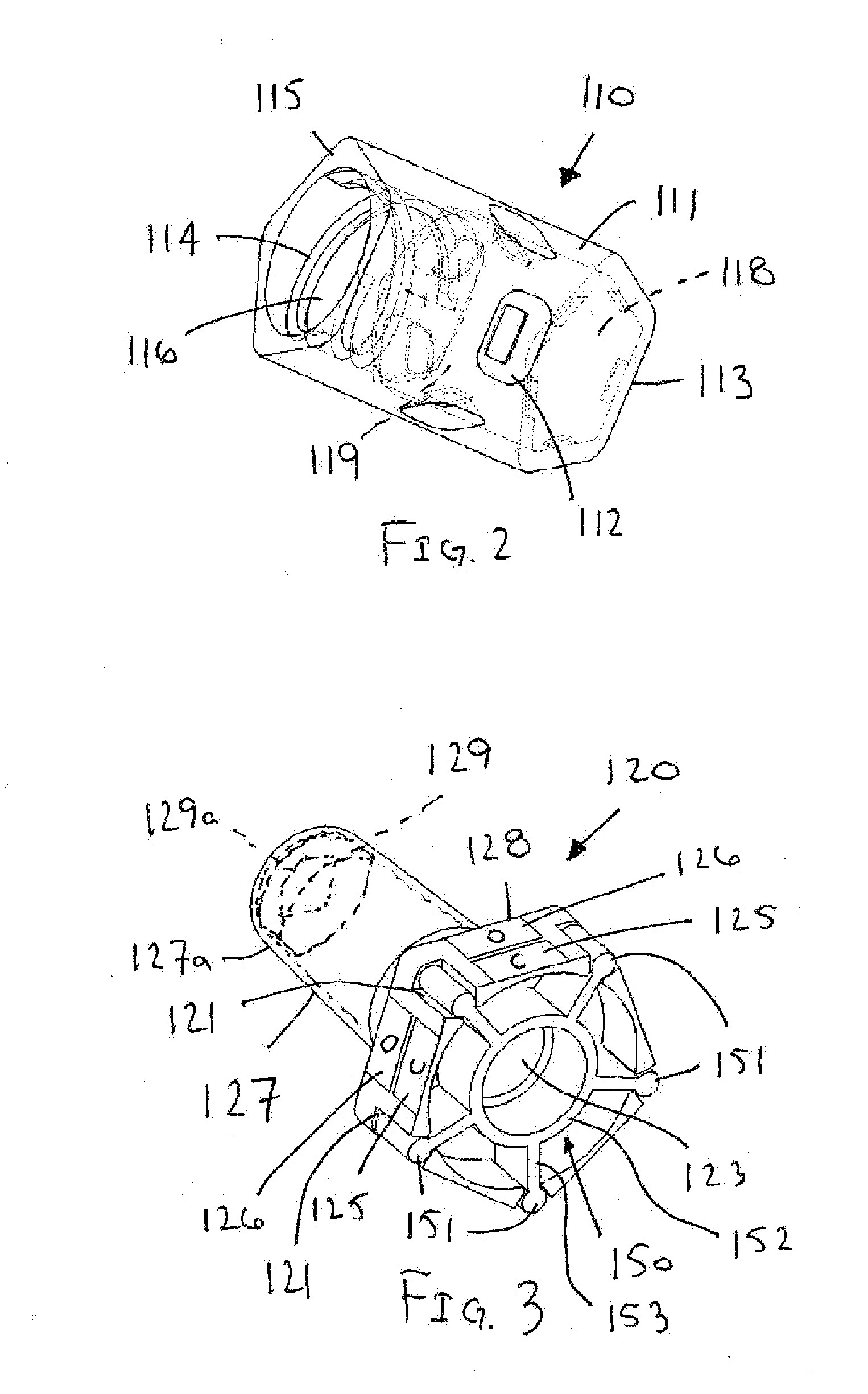[0012]Conventional devices and assemblies for establishing medical connections are not completely effective and are potentially unsafe. For example, conventional medical connectors may
expose the user to harmful agents during disconnection as a result of undesired bolus effects, may collect undesired fluid within their internal volumes after disconnection, may not notify the user of the actuation status during connection and disconnection, and / or may include many parts thereby making manufacture expensive. In contrast, embodiments herein may use fewer parts, may minimize and / or eliminate residual fluid within the connectors after disconnection, may utilize a rotational actuation force as opposed to translation force to avoid or create a desired bolus effect, and / or may incorporate actuation status indicators to notify the user when actuation is complete.
[0015]In accordance with an exemplary embodiment, a valve is provided for controlling flow along a fluid line that includes an outer shell and an inner housing slidably disposed therein that includes connector threads surrounding a boss on one end and a passage including a tapered region within the boss. A shaft within the valve includes a base coupled to the outer shell, a tapered sealing pin disposed within the tapered region, and a fluid passage extending through the base to outlets in the sealing pin. A connector may be threaded into the one end of the inner housing, thereby slidably engaging the connector threads, camming elements on the inner housing causing the inner housing to move helically from a closed position wherein the sealing pin engages the boss to seal the outlets and an open position wherein the inner housing is directed away from the sealing pin to open a fluid path through the valve.
[0028]In addition, the valve includes a shaft including a base coupled to the flexible member and extending through the inner housing passage towards the outer shell second end. In one embodiment, the shaft includes a tapered sealing pin disposed within the tapered region of the inner housing passage. For example, the flexible member may couple the backing member to the base of the shaft for directing the shaft distally when the
helical member is directed from the first position to the second position and for directing the shaft proximally when the
helical member is directed from the second position to the first position. For example, the flexible member may deflect when the
helical member is directed from the second position to the first position to create a vacuum within the fluid path to reduce
fluid leakage when the connector of the fluid path is unthreaded from the second end of the inner housing.
[0037]The tubular member may be disposed within the inner housing and may include a fluid passage therein extending between the second end of the outer shell and the boss of the inner housing. The tubular member may be carried by the inner housing such that the tubular member moves axially as the inner housing moves between the first and second positions. The connector
assembly may also include
cam features on the outer shell and / or the tubular member for causing the tubular member to rotate as the inner housing moves between the first and second positions, thereby opening a fluid path between the fluid passage in the tubular member and the first end of the outer shell.
[0039]In accordance with another embodiment, a connector and / or valve
assembly is provided for controlling flow in a fluid line that includes an outer shell including a first end, a second end, and a passage extending therebetween, the first end including a connector for connecting the
assembly to a fluid line; an inner housing disposed within the outer shell and including a boss disposed adjacent the first end, the inner housing being movable axially within the outer shell between a first position adjacent the first end and a second position further from the first end than the first position when a device is connected to the connector on the first end of the outer shell; a tubular member disposed within the inner housing and including a fluid passage therein extending between the second end of the outer shell and the boss of the inner housing, the tubular member carried by the inner housing such that the tubular member moves axially as the inner housing moves between the first and second positions; and
cam features on the inner housing and the tubular member for causing the tubular member to rotate as the inner housing moves between the first and second positions, thereby opening a fluid path between the fluid passage in the tubular member and the first end of the outer shell to allow fluid flow through the assembly with the device connected to the first end of the outer shell.
[0040]In accordance with another embodiment, a connector assembly for controlling flow in a fluid line is provided that includes an outer shell or bezel including a first end, a second end, and a passage extending therebetween, the first end including a connector for connecting the assembly to a fluid line. An inner housing may be disposed within the outer shell that includes a boss disposed adjacent the first end, the inner housing being movable axially within the outer shell between a first position adjacent the first end and a second position further from the first end than the first position when a device is connected to the connector on the first end of the outer shell. A backing member may be coupled to the second end of the outer shell such that the outer shell is substantially axially fixed relative to the backing member and rotatable relative to the backing member, the backing member slidably coupled to the inner housing such that the inner housing moves helically relative to the backing member when the inner housing is directed from the first position towards the second position. A tubular member may include a first end disposed within the inner housing and a second end extending through the backing member, the tubular member slidably coupled to the backing member such that the tubular member substantially rotationally fixed relative to the backing member and is movable axially relative to the backing member, the tubular member comprising a fluid passage therein extending between the first and second ends. A seal on the boss may engage the first end of the tubular member in the first position to substantially seal the fluid passage, and
cam features may be provided on the inner housing and the tubular member for
coupling axial movement of the tubular member to axial movement of the inner housing when the inner housing is initially moved from the first position towards the second position, the cam features causing the tubular member to move distally relative to the inner housing immediately before the inner housing reaches the second position, thereby disengaging the seal from the first end of the tubular member and opening the fluid passage.
 Login to View More
Login to View More  Login to View More
Login to View More 


